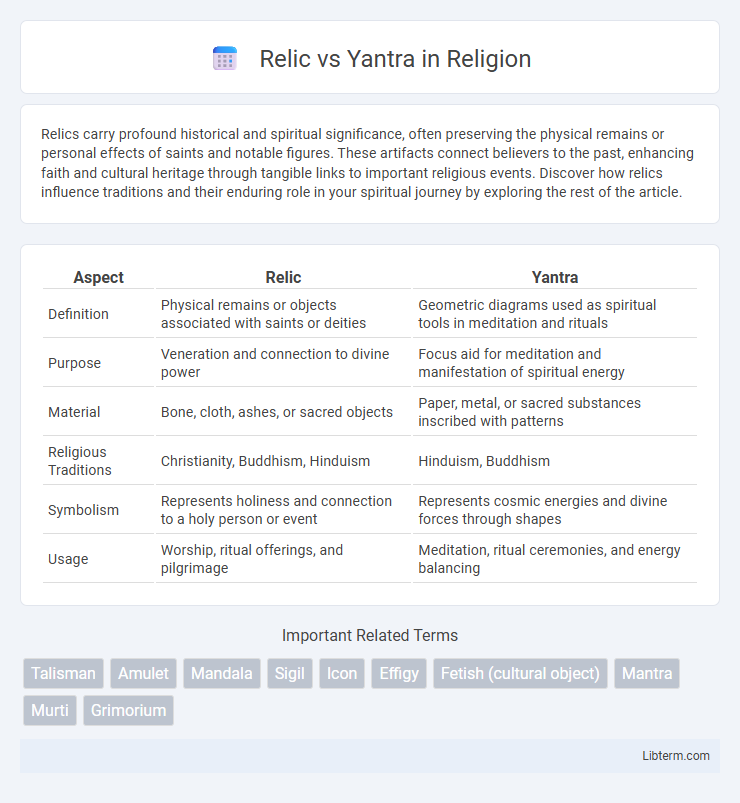Relics carry profound historical and spiritual significance, often preserving the physical remains or personal effects of saints and notable figures. These artifacts connect believers to the past, enhancing faith and cultural heritage through tangible links to important religious events. Discover how relics influence traditions and their enduring role in your spiritual journey by exploring the rest of the article.
Table of Comparison
| Aspect | Relic | Yantra |
|---|---|---|
| Definition | Physical remains or objects associated with saints or deities | Geometric diagrams used as spiritual tools in meditation and rituals |
| Purpose | Veneration and connection to divine power | Focus aid for meditation and manifestation of spiritual energy |
| Material | Bone, cloth, ashes, or sacred objects | Paper, metal, or sacred substances inscribed with patterns |
| Religious Traditions | Christianity, Buddhism, Hinduism | Hinduism, Buddhism |
| Symbolism | Represents holiness and connection to a holy person or event | Represents cosmic energies and divine forces through shapes |
| Usage | Worship, ritual offerings, and pilgrimage | Meditation, ritual ceremonies, and energy balancing |
Introduction to Relics and Yantras
Relics are sacred objects, often physical remains or artifacts associated with spiritual figures, revered across various religious traditions for their believed mystical powers and historical significance. Yantras are geometric diagrams used in Hindu and Buddhist meditation, symbolizing cosmic energies to harness spiritual focus and protection. Both relics and yantras serve as powerful tools in spiritual practice, connecting practitioners to divine energies through physical and symbolic means.
Historical Background of Relics
Relics hold significant historical value, often serving as tangible remains of saints or religious figures from ancient civilizations, particularly within Buddhism, Christianity, and Hinduism. These sacred objects, such as bones, clothing, or personal artifacts, were venerated across centuries for their perceived spiritual power and connection to divine blessings. The tradition of collecting and preserving relics dates back to early religious practices, symbolizing faith, protection, and continuity of spiritual heritage.
Origins and Evolution of Yantras
Yantras originate from ancient Indian spiritual traditions, serving as geometric diagrams designed to harness cosmic energy for meditation and ritual purposes. These symbolic patterns evolved over millennia, integrating elements of sacred geometry, numerology, and mantras to facilitate deeper states of consciousness. Unlike relics, which are physical artifacts with historical significance, yantras function primarily as metaphysical tools aimed at spiritual transformation and energy alignment.
Symbolism: Relic vs Yantra
Relics symbolize tangible connections to spiritual heritage, often embodying the physical presence or essence of revered figures, making them powerful objects of devotion. Yantras represent geometric diagrams that embody cosmic energies and serve as tools for meditation, focusing spiritual intentions and channeling universal forces. Both relics and yantras hold profound symbolic significance in spiritual practices, with relics emphasizing physical sanctity and yantras emphasizing metaphysical harmony.
Religious and Spiritual Significance
Relics hold profound religious significance as sacred physical remains associated with saints or deities, believed to embody divine power and spiritual blessings across various faith traditions. Yantras, geometric diagrams used predominantly in Hinduism and Buddhism, serve as spiritual tools for meditation, protection, and invoking cosmic energies, symbolizing deeper metaphysical concepts. Both relics and yantras facilitate a tangible connection to the divine, enhancing spiritual practices through physical presence and symbolic representations.
Rituals and Practices Involving Relics
Rituals involving relics often include veneration ceremonies where devotees offer flowers, incense, and prayers to sacred objects believed to embody spiritual energy or the presence of saints. These practices emphasize direct physical connection and reverence, such as the circumambulation of relic-containing shrines and the performance of specific rites during festivals or pilgrimages. Unlike yantras, which are geometric diagrams used primarily for meditation and invocation of deities, relics serve as tangible focal points in devotional rituals to invoke blessings and divine protection.
Yantras in Meditation and Worship
Yantras are geometric diagrams used in meditation and worship to focus the mind and channel spiritual energy, often associated with specific deities in Hinduism and Tantric traditions. These sacred symbols enhance concentration, aid in achieving deeper states of meditation, and are believed to embody cosmic energies that facilitate spiritual growth. Unlike relics, which are physical objects tied to historical or religious significance, yantras function as visual tools that activate spiritual vibrations through precise designs and mantras.
Physical Form: Material and Design Differences
Relics are typically physical remnants of saints or historical religious figures, often encased in ornate reliquaries made from precious metals such as gold, silver, or bronze, emphasizing the sacredness and authenticity of the artifact. Yantras, in contrast, are symbolic geometric diagrams traditionally inscribed on materials like paper, metal plates, or cloth, designed with precise mathematical patterns representing cosmic energies and spiritual concepts. The material composition of relics stresses tangible veneration, whereas yantras focus on visual and energetic symbolism embedded in their geometric design.
Regional and Cultural Variations
Relics and yantras hold distinct roles across different regions and cultures, with relics typically revered in Buddhist and Christian traditions as physical remains or objects associated with saints, symbolizing spiritual power and historical continuity. Yantras, primarily rooted in Hindu and Tantric practices, are intricate geometric designs used as meditation aids and tools for channeling cosmic energies, reflecting diverse artistic styles and ritualistic uses throughout South Asia. These differences underscore how religious symbolism adapts to regional beliefs and cultural contexts, highlighting the unique spiritual significance attributed to tangible objects versus abstract iconography.
Modern Perspectives on Relics and Yantras
Modern perspectives on relics emphasize their role in cultural heritage, spiritual connection, and historical continuity, often integrating scientific methods for authentication and preservation. Yantras are increasingly viewed through the lens of geometry and meditation, with contemporary practitioners using them as tools for mindfulness and energy balancing. Both relics and yantras intersect in their function as tangible focal points for intangible spiritual experiences, gaining renewed interest in global wellness and esoteric studies.
Relic Infographic

 libterm.com
libterm.com